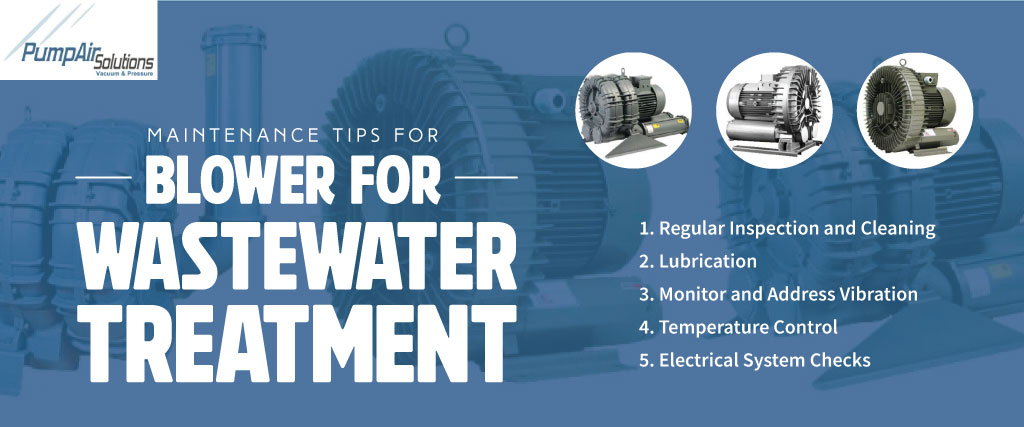Blowers are essential for wastewater treatment systems as they supply the aeration required for organic matter’s biological breakdown. Therefore, regular maintenance is essential to ensure such industrial equipment’s reliable and effective operation. Proper maintenance improves the overall performance and extends the lifespan of the blower for wastewater treatment. In this blog, we have discussed some important blower maintenance guidelines for wastewater treatment plants.
You can also read our blog: Blower For Wastewater Treatment Enhancing the Quality of Water
1- Regular Inspection and Cleaning
Basic maintenance tasks like routine cleaning and inspection help avoid any problems before they become serious ones.
Inspect Filters -
Check air filters regularly for debris and dirt. Clogged filters can restrict airflow, and pressure blower, and cause damage or inefficiency. Maintaining ideal airflow requires periodic filter cleaning or replacement.
Check air filters regularly for debris and dirt. Clogged filters can restrict airflow, and pressure blower, and cause damage or inefficiency. Maintaining ideal airflow requires periodic filter cleaning or replacement.
Clean Blower Components :-
Impellers, casings, and motor housings are just a few of the parts of a blower for wastewater treatment that can collect dust and debris. Maintain regular cleanings on these components to avoid accumulation that might block performance and lead to overheating.
2- Lubrication
The flawless functioning of blower components, especially bearings and moving parts, depends on proper lubrication.
Check Lubrication Levels: -
Ensure the bearings and other moving parts have enough lubricant. Increased friction from inadequate lubrication can result in wear and tear and even failure.
Use the Right Lubricant: -
Make sure you use the lubricants suggested by the manufacturer. The blower components can sustain damage or lose performance with the wrong type of lubricant.
Establish a Lubrication Schedule: -
Maintain a regular lubrication schedule based on your blower’s working parameters and the manufacturer’s instructions. Regular lubrication extends the blower’s lifespan and helps in performance maintenance.
3- Monitor and Address Vibration
Excessively strong vibrations can indicate more serious problems like imbalance, misalignment, or damaged parts.
Regular Vibration Monitoring : -
Look for any strange vibration patterns from the blower for wastewater treatment by using vibration analysis tools. Early detection of alterations can help avoid serious damage.
Check Alignment and Balance : -
Ensure the blower and its motor are balanced and oriented correctly. Unbalance and misalignment can result in excessive vibration and early component wear.
Tighten Loose Components : -
Ensure all bolts, nuts, and other connections are tight. Vibrations from loose parts could eventually damage the blower.
4- Monitor and Address Vibration
Temperature management is essential to prevent overheating in blower for wastewater treatment as these industrial equipment run continuously.
Monitor Operating Temperature : -
Look for the blower’s operating temperature regularly as overheating can indicate mechanical faults, inadequate ventilation, or an excessive load.
Ensure Adequate Ventilation : -
Check for enough airflow surrounding the blower for wastewater treatment to dissipate heat. Ensure that the cooling fans are operating properly and clear any debris from the ventilation channels.
Adjust Load as Needed : -
Ensure the blower isn’t running above its limit as overloading can cause the motor to overheat. Increase the blower’s power by upgrading or adjusting the load if required.
5- Electrical System Checks
Reliability of functioning depends on the maintenance of the electrical components of the blower for wastewater treatment.
Inspect Wiring and Connections : -
Look for wear, fraying, or damage on all wiring and connections regularly. Loose or broken wiring can cause operational problems and electrical failures.
Test Electrical Components : -
Use a multimeter to test electrical parts like relays, switches, and capacitors. Replace any defective parts to ensure the proper operation of the blower.
Professional Servicing : -
Consult a trained technician for help with more complicated electrical problems. Expert maintenance can stop additional harm and ensure the electrical system of the blower for wastewater treatment is operating securely and effectively.
Final Thoughts -
Blowers for Wastewater Treatment systems require regular maintenance to operate effectively and dependably. Industries can extend the life of their blowers, avoid downtime, and save operating expenses by performing regular tests, cleaning, lubrication, vibration monitoring, temperature management, and electrical system checks. Keeping thorough records of every maintenance task makes it easier to monitor progress and detect possible problems early. By implementing these maintenance recommendations, the performance and dependability of the blower for wastewater treatment can be greatly improved.
Side Channel Blowers is a reliable platform where we offer effective aeration to help biological activities. The robust design of our blower for wastewater treatment ensures steady airflow, improving treatment efficacy and energy economy. Moreover, It is a cost-effective option for wastewater management as it is perfect for continuous operation and requires little maintenance. Visit our website today at Side Channel Blowers to learn more about our equipment in detail.

